Malignant Wound Care Management
VerifiedAdded on 2021/04/16
|20
|1306
|135
Presentation
AI Summary
This assignment provides a comprehensive overview of malignant wound care management. It includes various studies and research papers on the topic, such as the use of metronidazole for malodorous control and the impact of evidence-based practice in nursing. The assignment also covers systemic antibiotics for treating malignant wounds and the meaning of living with an unbounded body. Additionally, it discusses symptom burden and quality of life in patients with malignant fungating wounds.
Contribute Materials
Your contribution can guide someone’s learning journey. Share your
documents today.
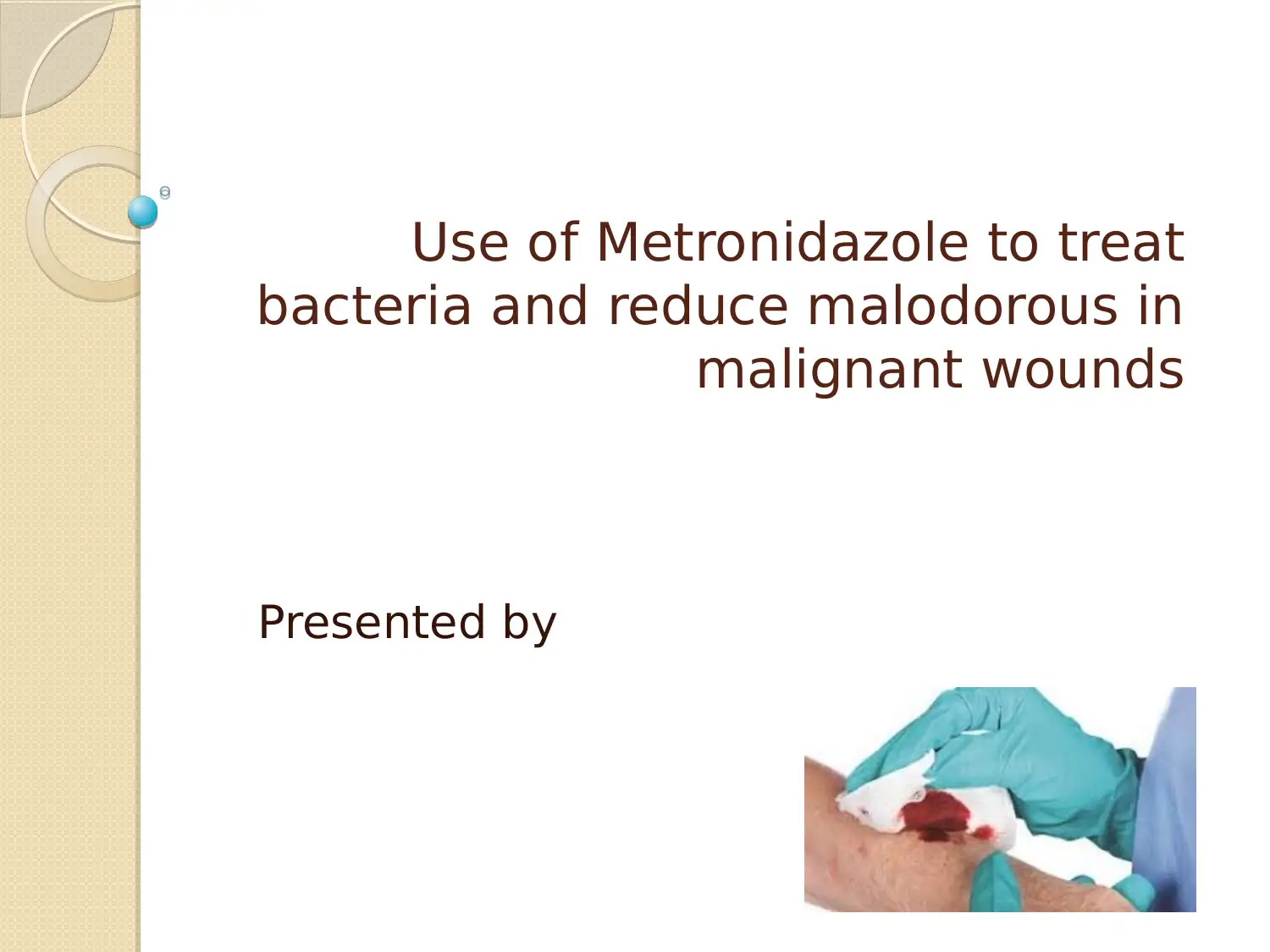
Use of Metronidazole to treat
bacteria and reduce malodorous in
malignant wounds
Presented by
bacteria and reduce malodorous in
malignant wounds
Presented by
Secure Best Marks with AI Grader
Need help grading? Try our AI Grader for instant feedback on your assignments.
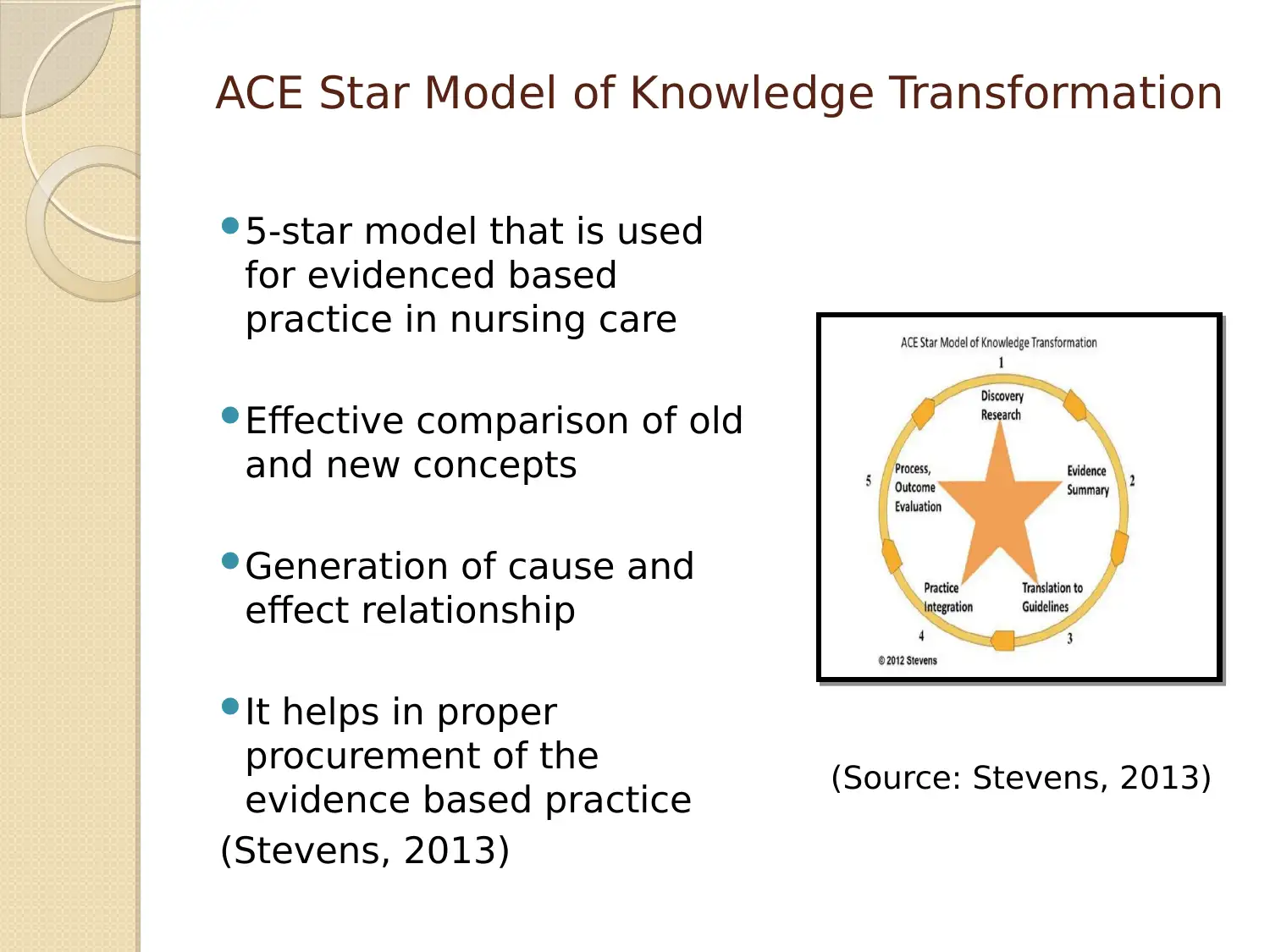
ACE Star Model of Knowledge Transformation
5-star model that is used
for evidenced based
practice in nursing care
Effective comparison of old
and new concepts
Generation of cause and
effect relationship
It helps in proper
procurement of the
evidence based practice
(Stevens, 2013)
(Source: Stevens, 2013)
5-star model that is used
for evidenced based
practice in nursing care
Effective comparison of old
and new concepts
Generation of cause and
effect relationship
It helps in proper
procurement of the
evidence based practice
(Stevens, 2013)
(Source: Stevens, 2013)
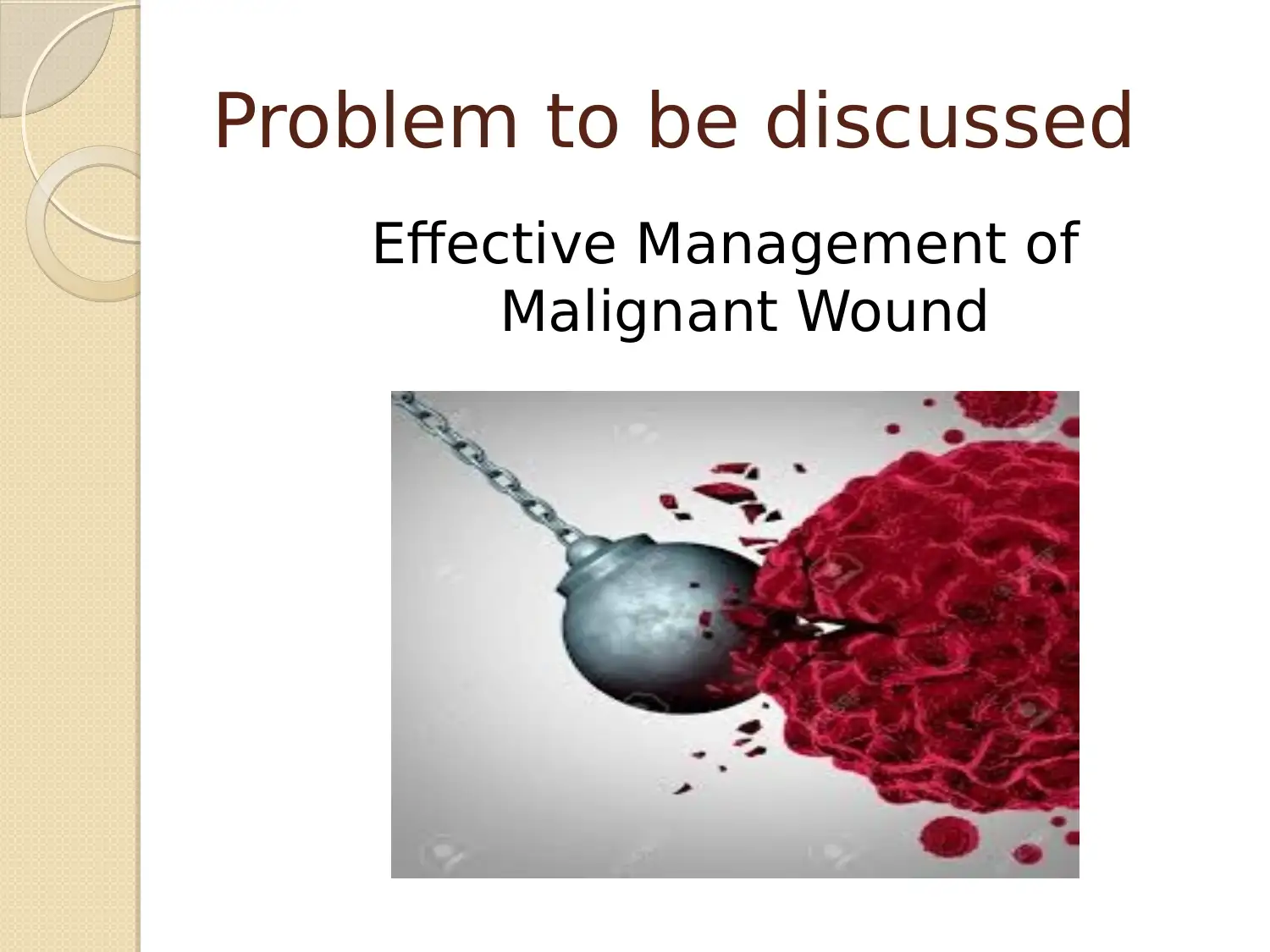
Problem to be discussed
Effective Management of
Malignant Wound
Effective Management of
Malignant Wound
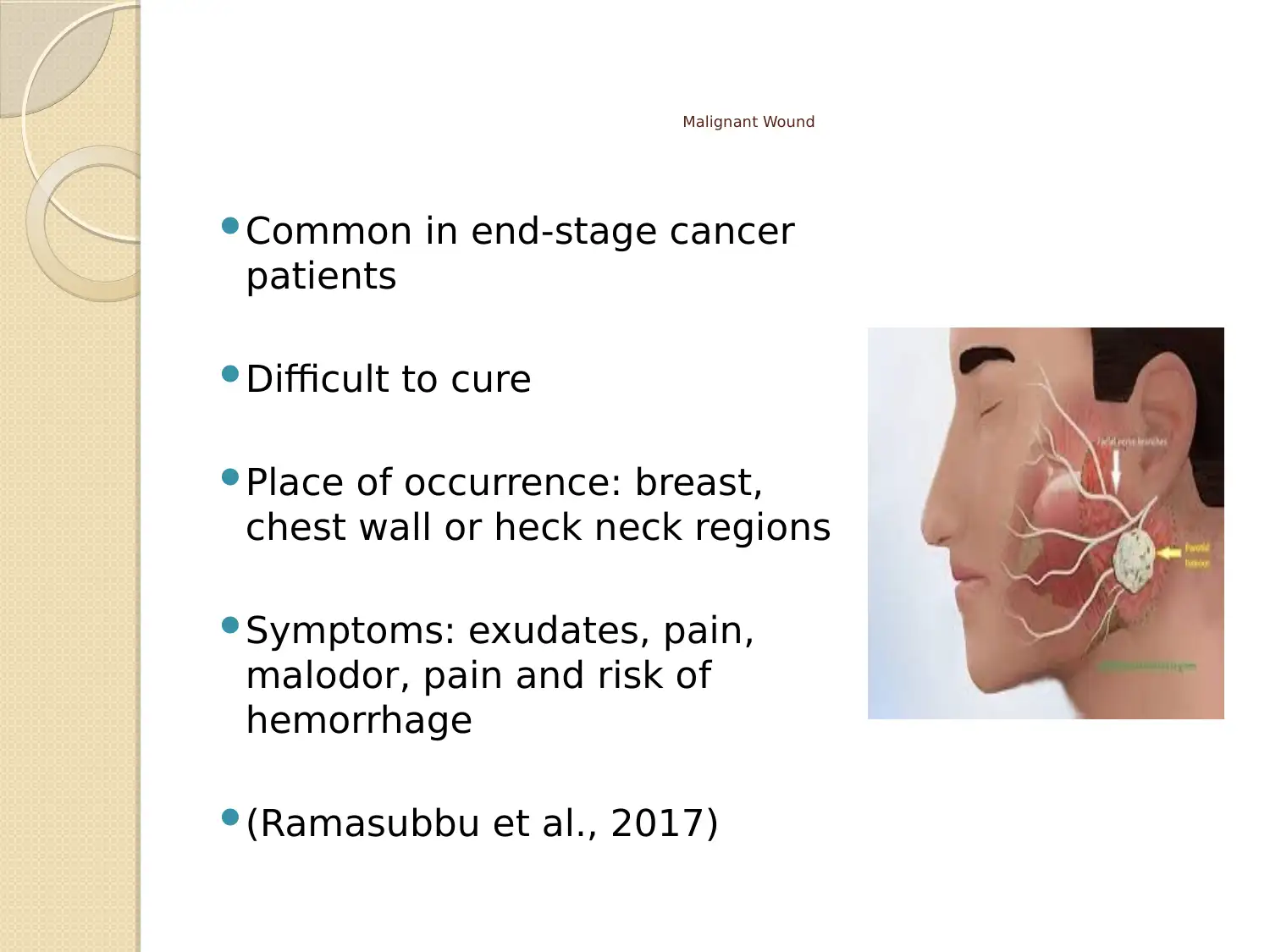
Malignant Wound
Common in end-stage cancer
patients
Difficult to cure
Place of occurrence: breast,
chest wall or heck neck regions
Symptoms: exudates, pain,
malodor, pain and risk of
hemorrhage
(Ramasubbu et al., 2017)
Common in end-stage cancer
patients
Difficult to cure
Place of occurrence: breast,
chest wall or heck neck regions
Symptoms: exudates, pain,
malodor, pain and risk of
hemorrhage
(Ramasubbu et al., 2017)
Secure Best Marks with AI Grader
Need help grading? Try our AI Grader for instant feedback on your assignments.
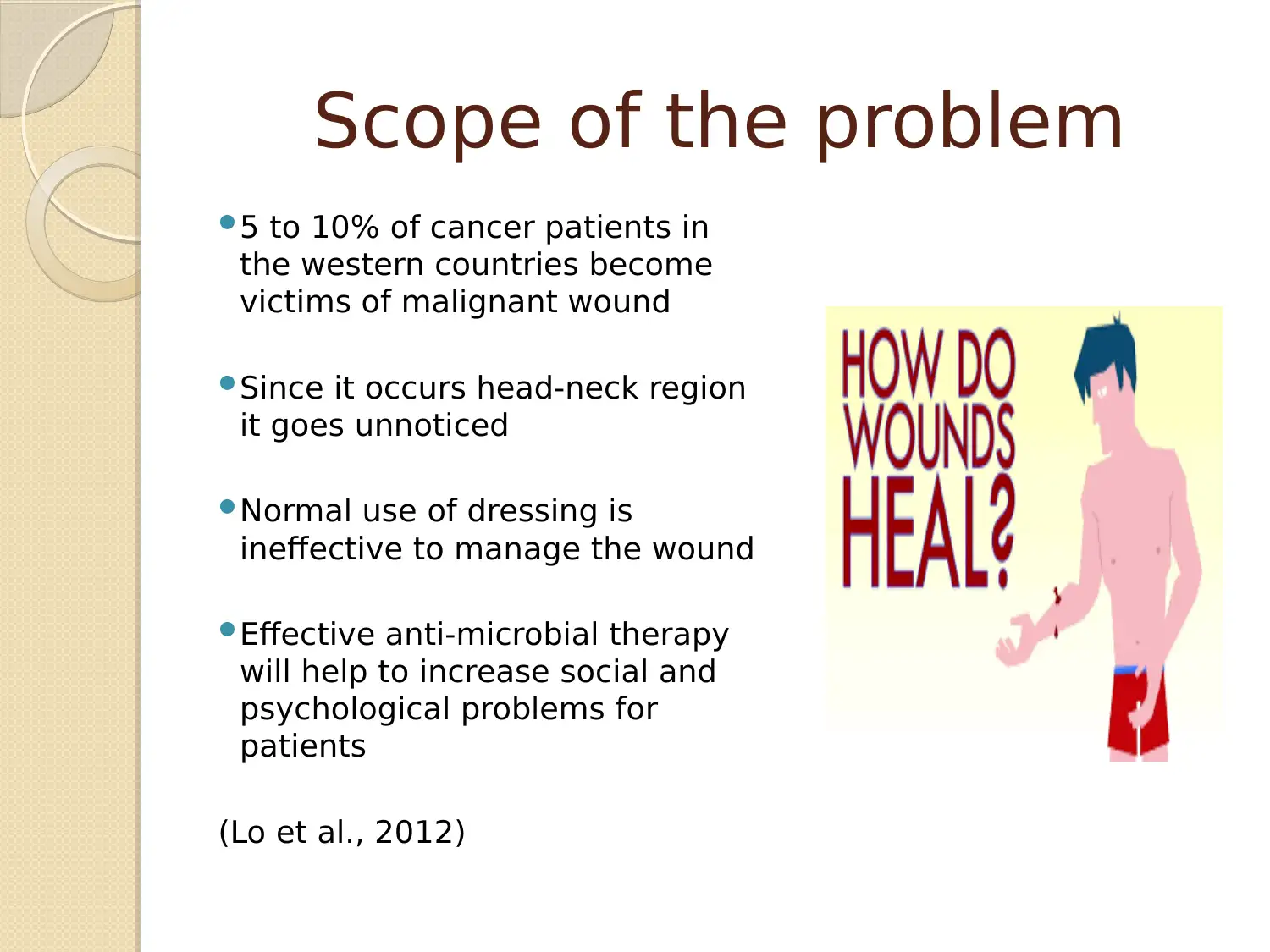
Scope of the problem
5 to 10% of cancer patients in
the western countries become
victims of malignant wound
Since it occurs head-neck region
it goes unnoticed
Normal use of dressing is
ineffective to manage the wound
Effective anti-microbial therapy
will help to increase social and
psychological problems for
patients
(Lo et al., 2012)
5 to 10% of cancer patients in
the western countries become
victims of malignant wound
Since it occurs head-neck region
it goes unnoticed
Normal use of dressing is
ineffective to manage the wound
Effective anti-microbial therapy
will help to increase social and
psychological problems for
patients
(Lo et al., 2012)
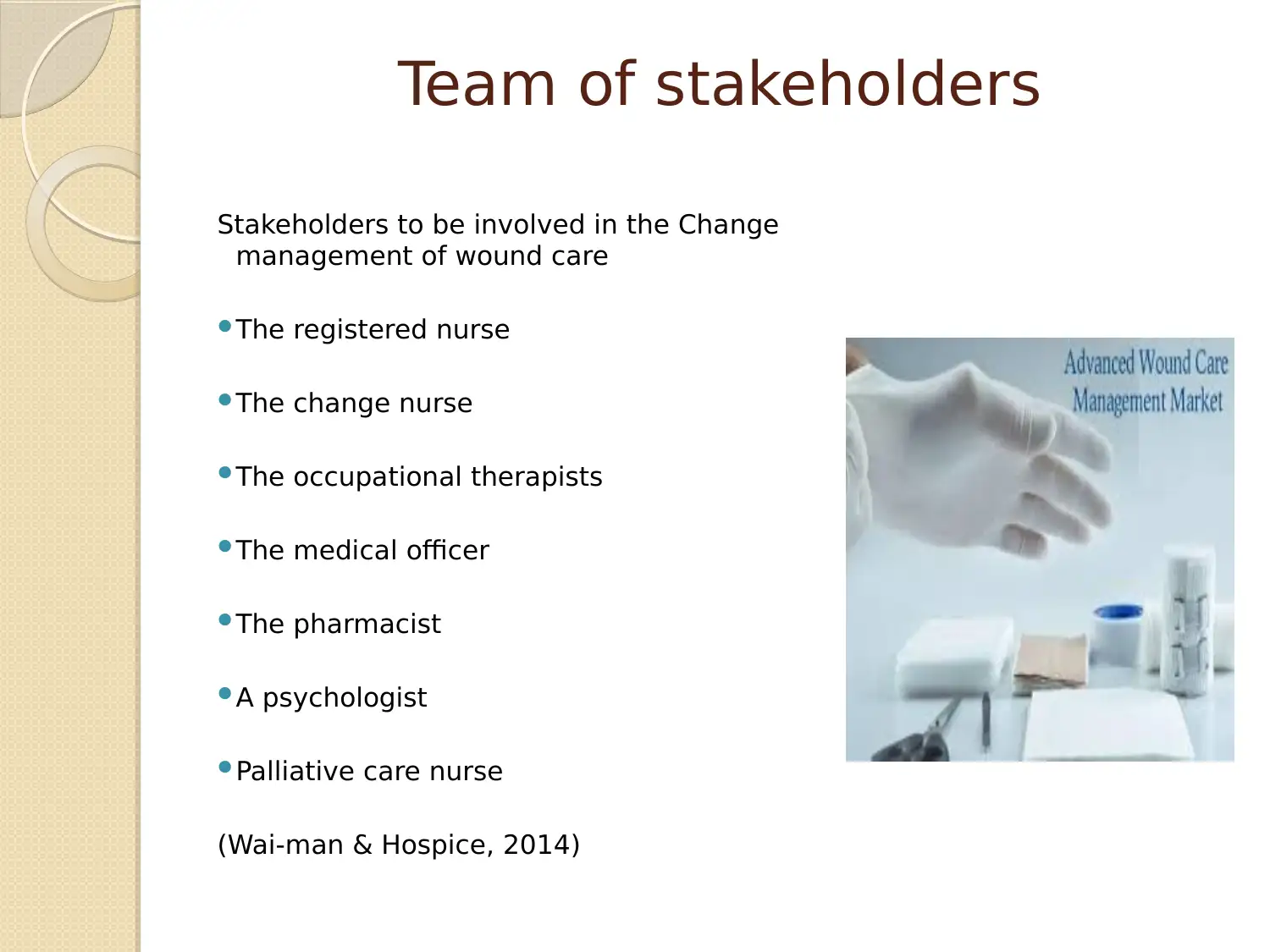
Team of stakeholders
Stakeholders to be involved in the Change
management of wound care
The registered nurse
The change nurse
The occupational therapists
The medical officer
The pharmacist
A psychologist
Palliative care nurse
(Wai-man & Hospice, 2014)
Stakeholders to be involved in the Change
management of wound care
The registered nurse
The change nurse
The occupational therapists
The medical officer
The pharmacist
A psychologist
Palliative care nurse
(Wai-man & Hospice, 2014)

Other stakeholders
include
Patient and their family
members
This is because it is
important for the care
members of the family and
the patients in know about
the reason of the procured
treatment and effective
outcome.
(Wai-man & Hospice, 2014)
include
Patient and their family
members
This is because it is
important for the care
members of the family and
the patients in know about
the reason of the procured
treatment and effective
outcome.
(Wai-man & Hospice, 2014)
Paraphrase This Document
Need a fresh take? Get an instant paraphrase of this document with our AI Paraphraser
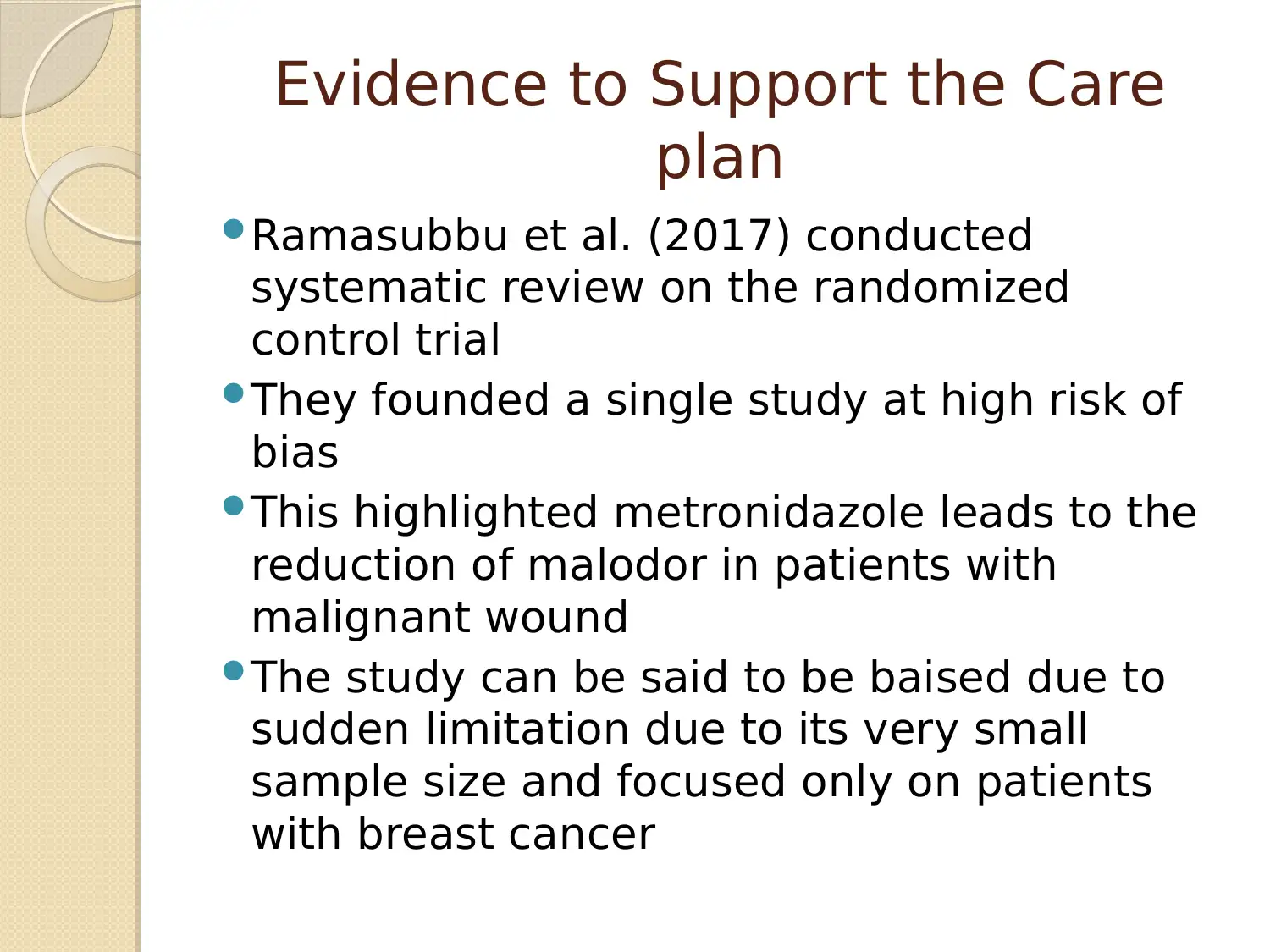
Evidence to Support the Care
plan
Ramasubbu et al. (2017) conducted
systematic review on the randomized
control trial
They founded a single study at high risk of
bias
This highlighted metronidazole leads to the
reduction of malodor in patients with
malignant wound
The study can be said to be baised due to
sudden limitation due to its very small
sample size and focused only on patients
with breast cancer
plan
Ramasubbu et al. (2017) conducted
systematic review on the randomized
control trial
They founded a single study at high risk of
bias
This highlighted metronidazole leads to the
reduction of malodor in patients with
malignant wound
The study can be said to be baised due to
sudden limitation due to its very small
sample size and focused only on patients
with breast cancer
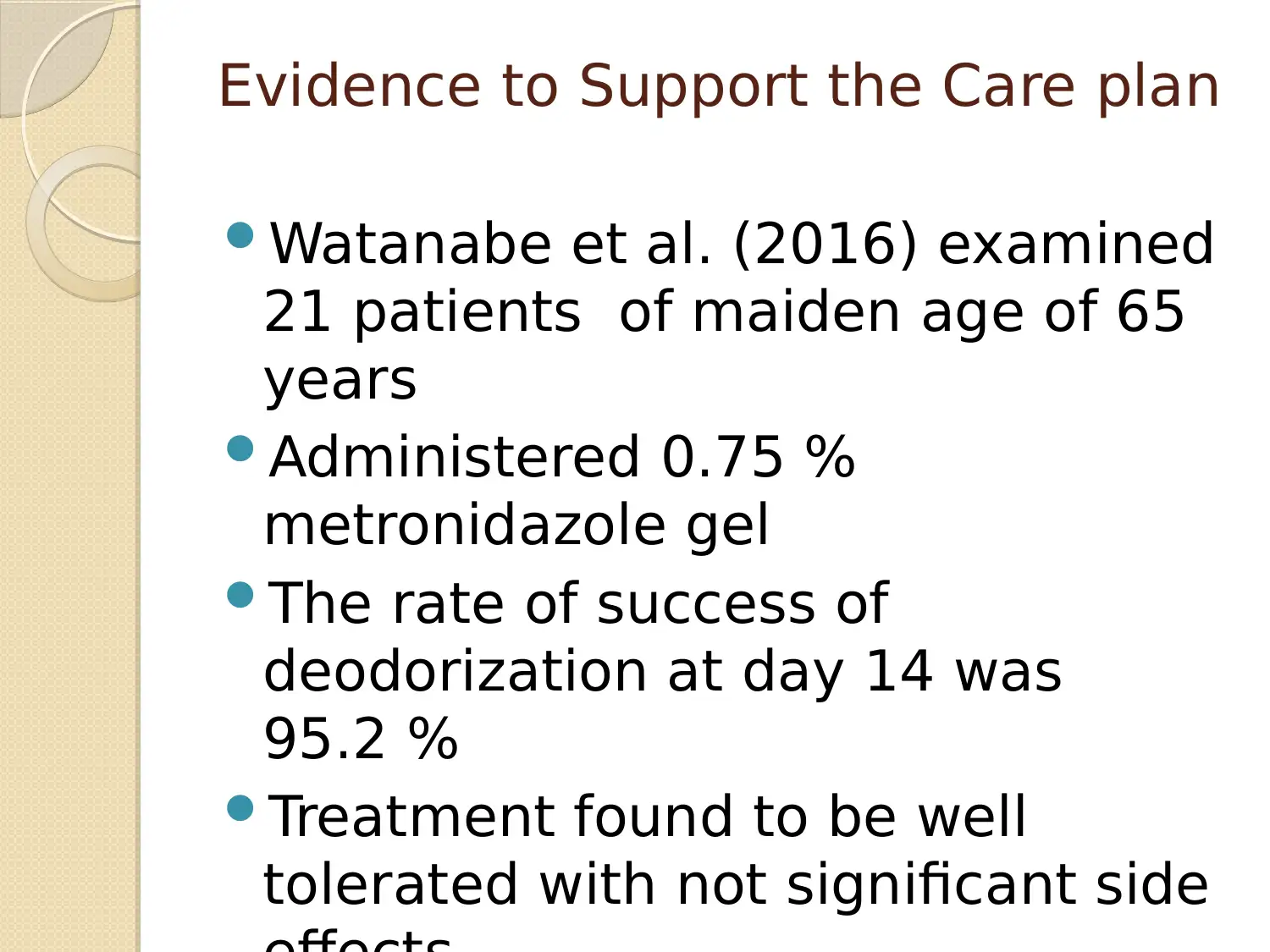
Evidence to Support the Care plan
Watanabe et al. (2016) examined
21 patients of maiden age of 65
years
Administered 0.75 %
metronidazole gel
The rate of success of
deodorization at day 14 was
95.2 %
Treatment found to be well
tolerated with not significant side
Watanabe et al. (2016) examined
21 patients of maiden age of 65
years
Administered 0.75 %
metronidazole gel
The rate of success of
deodorization at day 14 was
95.2 %
Treatment found to be well
tolerated with not significant side
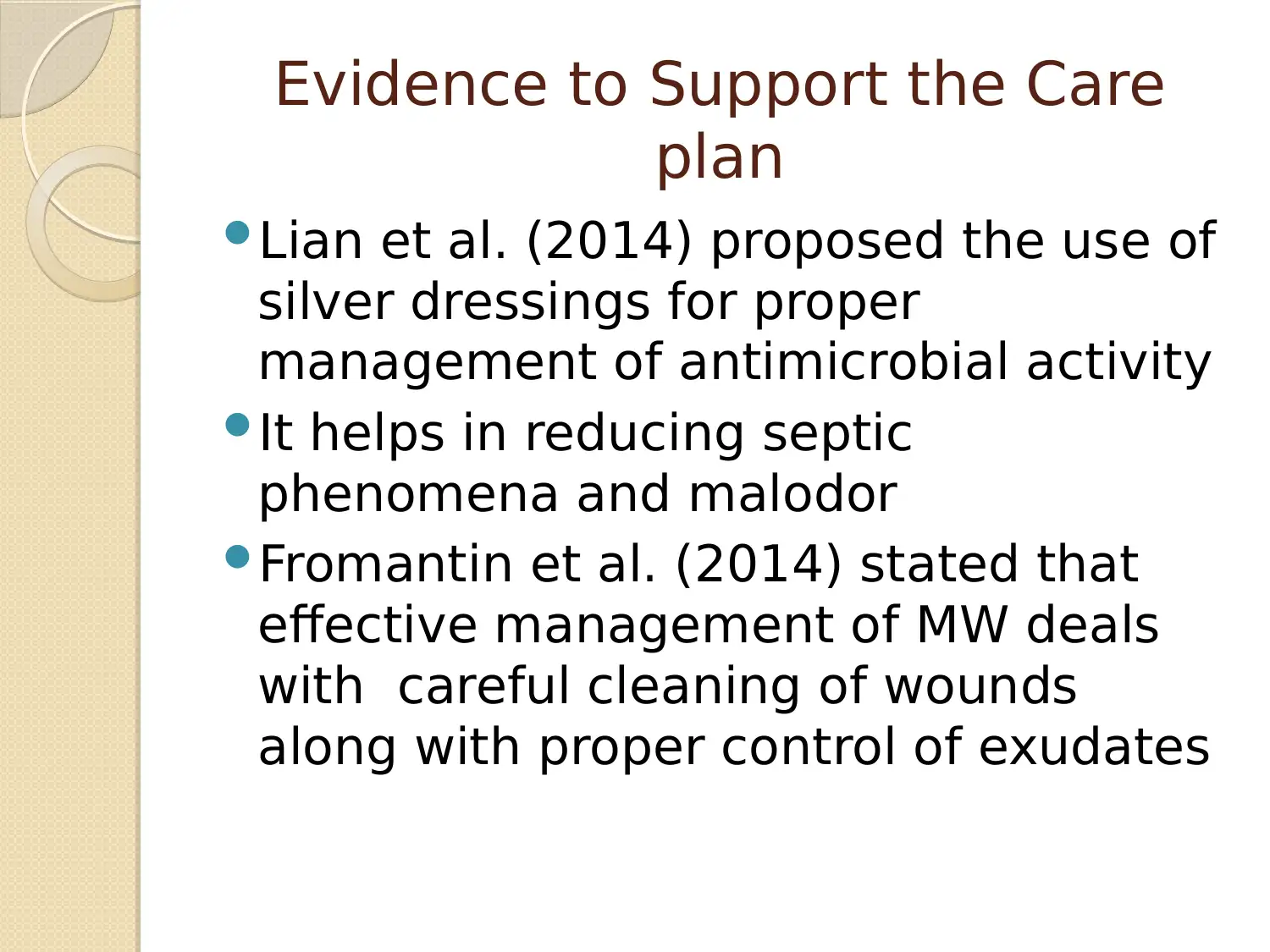
Evidence to Support the Care
plan
Lian et al. (2014) proposed the use of
silver dressings for proper
management of antimicrobial activity
It helps in reducing septic
phenomena and malodor
Fromantin et al. (2014) stated that
effective management of MW deals
with careful cleaning of wounds
along with proper control of exudates
plan
Lian et al. (2014) proposed the use of
silver dressings for proper
management of antimicrobial activity
It helps in reducing septic
phenomena and malodor
Fromantin et al. (2014) stated that
effective management of MW deals
with careful cleaning of wounds
along with proper control of exudates
Secure Best Marks with AI Grader
Need help grading? Try our AI Grader for instant feedback on your assignments.
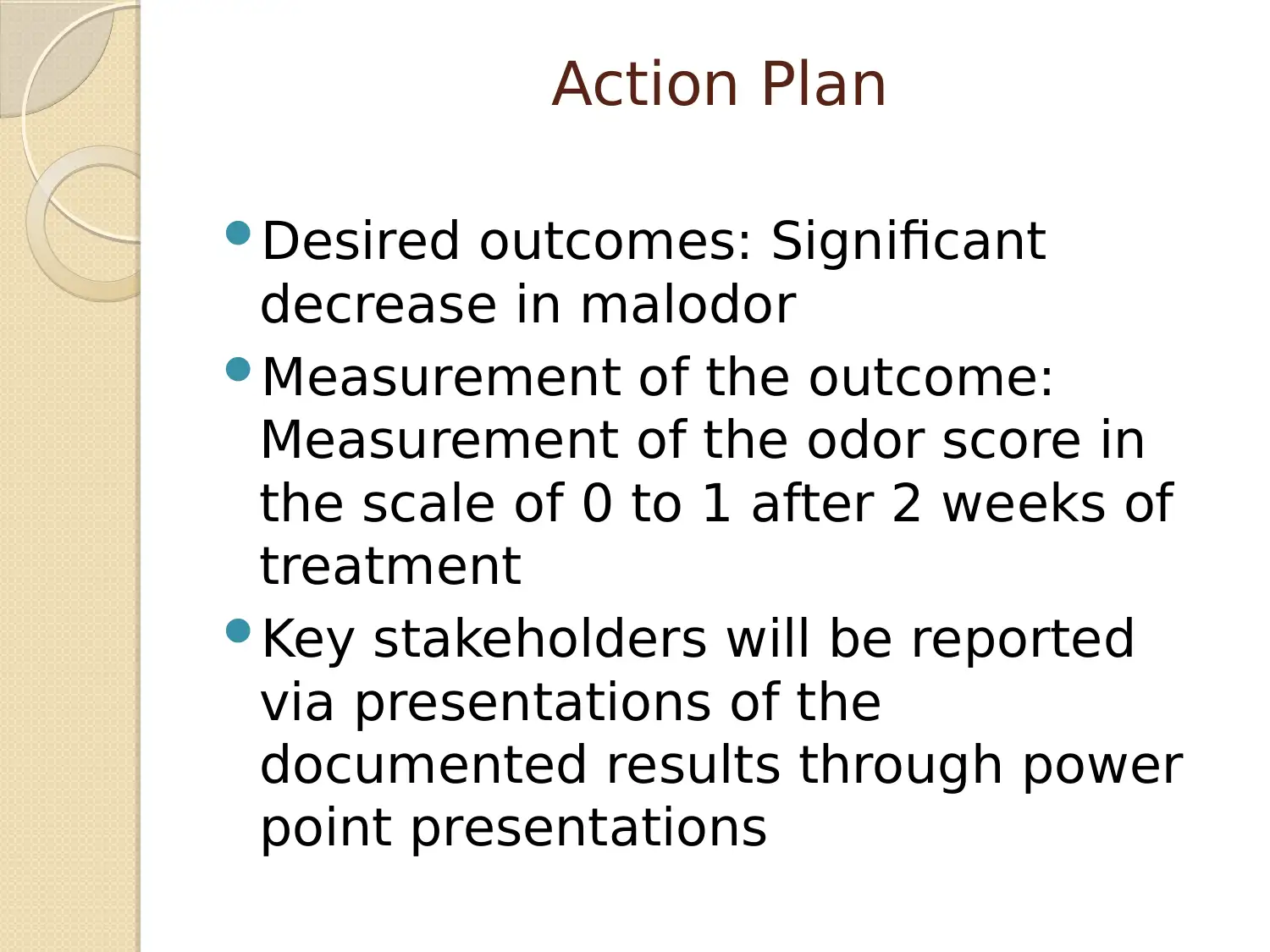
Action Plan
Desired outcomes: Significant
decrease in malodor
Measurement of the outcome:
Measurement of the odor score in
the scale of 0 to 1 after 2 weeks of
treatment
Key stakeholders will be reported
via presentations of the
documented results through power
point presentations
Desired outcomes: Significant
decrease in malodor
Measurement of the outcome:
Measurement of the odor score in
the scale of 0 to 1 after 2 weeks of
treatment
Key stakeholders will be reported
via presentations of the
documented results through power
point presentations
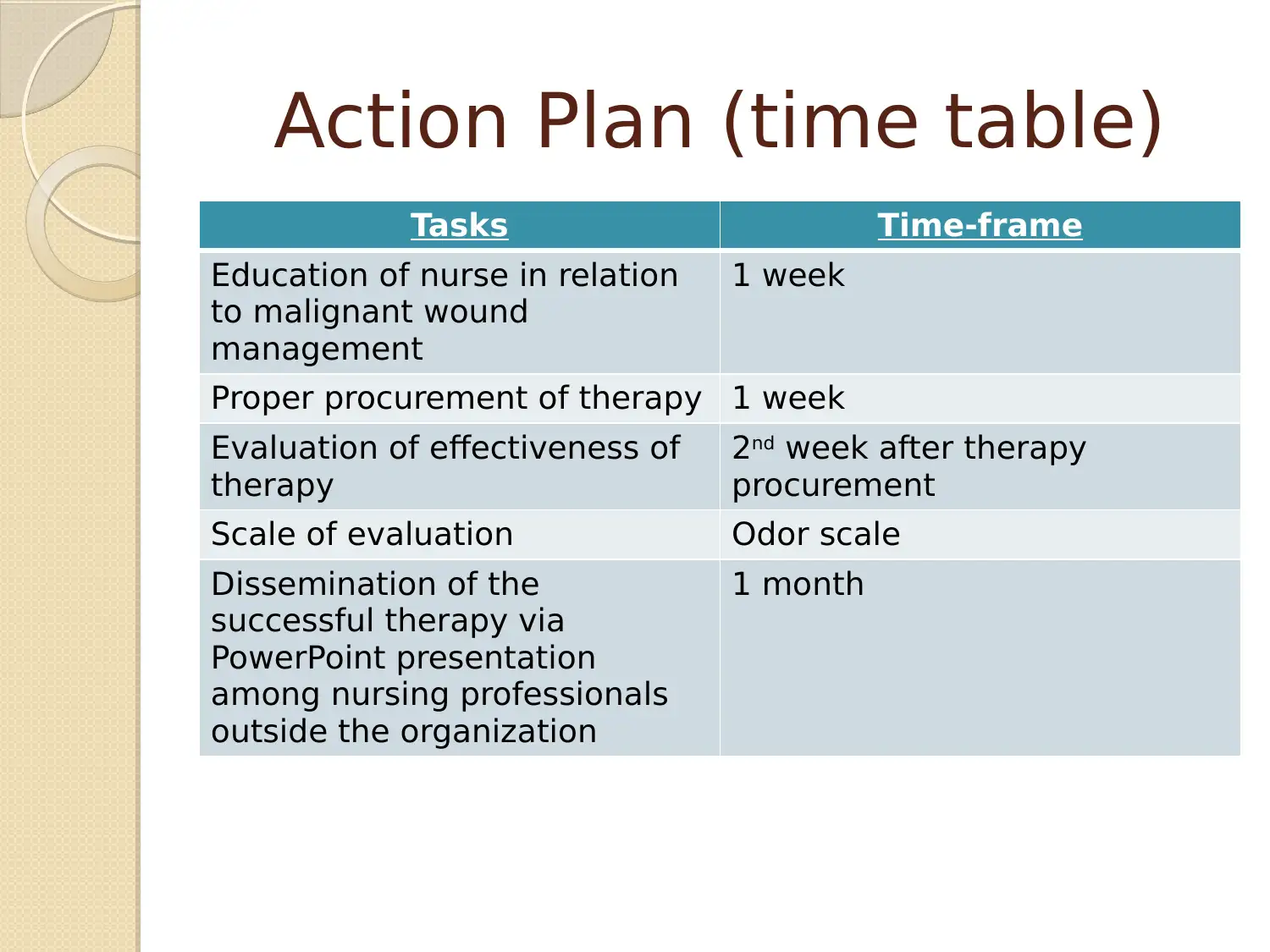
Action Plan (time table)
Tasks Time-frame
Education of nurse in relation
to malignant wound
management
1 week
Proper procurement of therapy 1 week
Evaluation of effectiveness of
therapy
2nd week after therapy
procurement
Scale of evaluation Odor scale
Dissemination of the
successful therapy via
PowerPoint presentation
among nursing professionals
outside the organization
1 month
Tasks Time-frame
Education of nurse in relation
to malignant wound
management
1 week
Proper procurement of therapy 1 week
Evaluation of effectiveness of
therapy
2nd week after therapy
procurement
Scale of evaluation Odor scale
Dissemination of the
successful therapy via
PowerPoint presentation
among nursing professionals
outside the organization
1 month
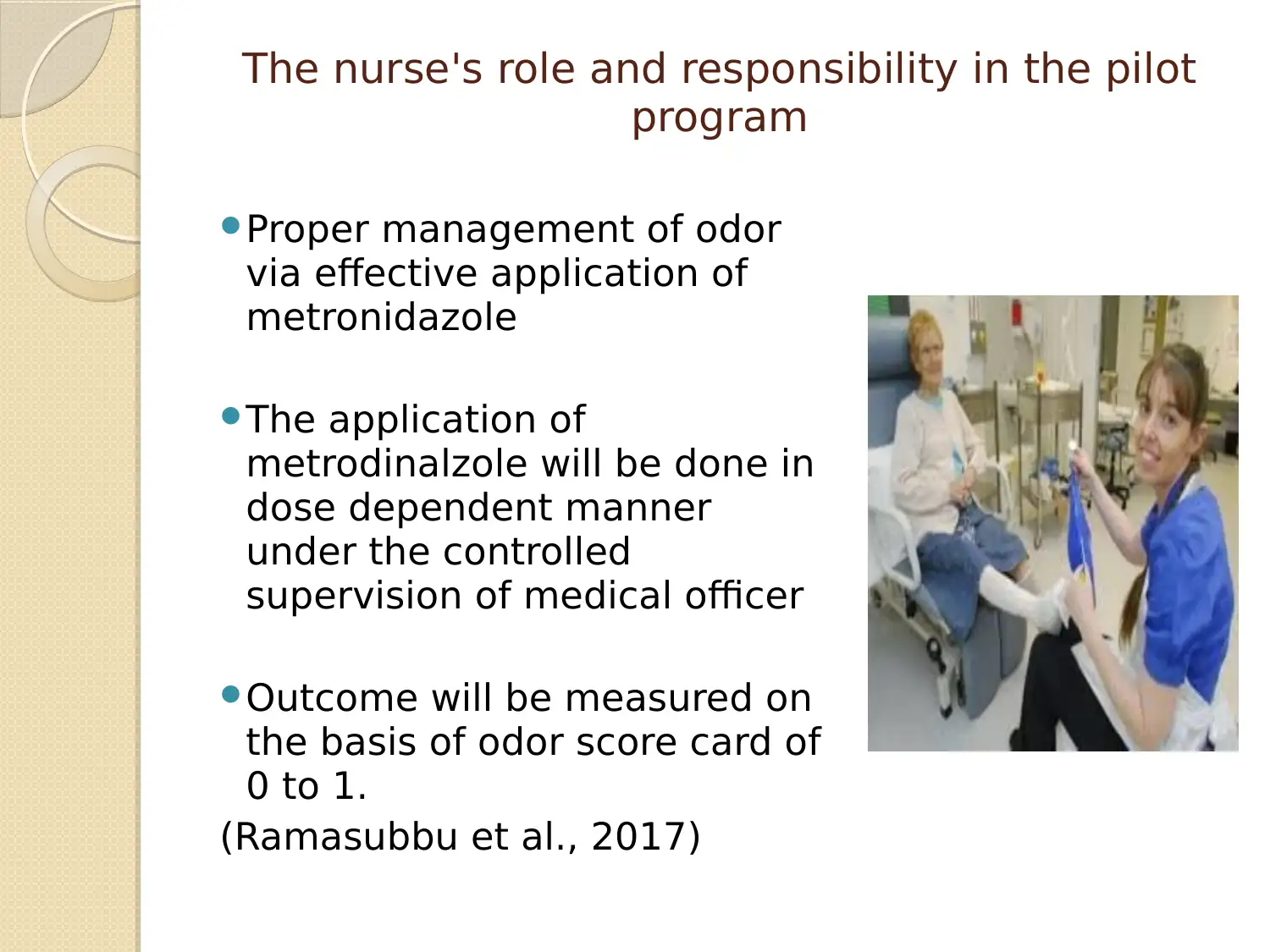
The nurse's role and responsibility in the pilot
program
Proper management of odor
via effective application of
metronidazole
The application of
metrodinalzole will be done in
dose dependent manner
under the controlled
supervision of medical officer
Outcome will be measured on
the basis of odor score card of
0 to 1.
(Ramasubbu et al., 2017)
program
Proper management of odor
via effective application of
metronidazole
The application of
metrodinalzole will be done in
dose dependent manner
under the controlled
supervision of medical officer
Outcome will be measured on
the basis of odor score card of
0 to 1.
(Ramasubbu et al., 2017)
Paraphrase This Document
Need a fresh take? Get an instant paraphrase of this document with our AI Paraphraser
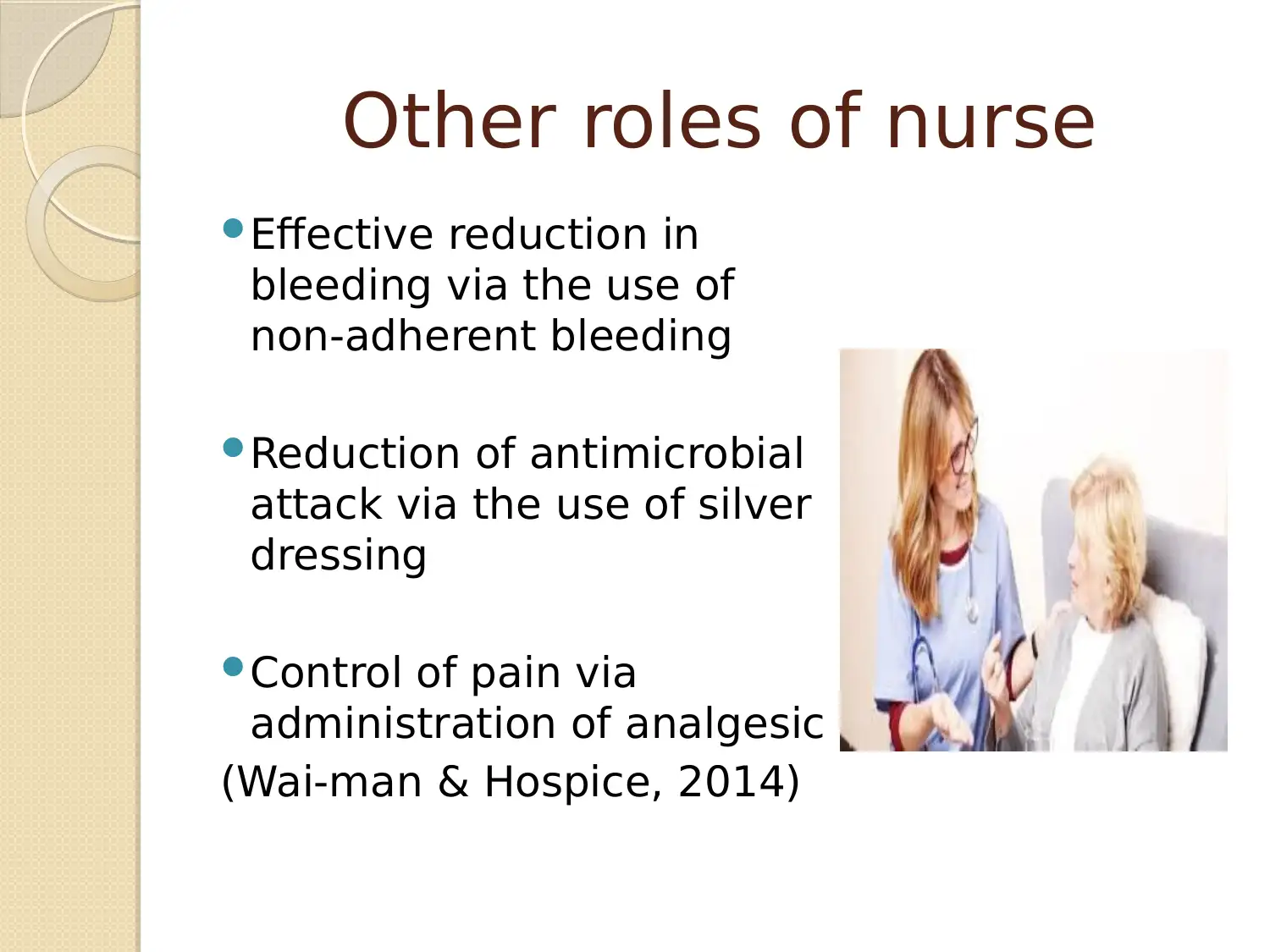
Other roles of nurse
Effective reduction in
bleeding via the use of
non-adherent bleeding
Reduction of antimicrobial
attack via the use of silver
dressing
Control of pain via
administration of analgesic
(Wai-man & Hospice, 2014)
Effective reduction in
bleeding via the use of
non-adherent bleeding
Reduction of antimicrobial
attack via the use of silver
dressing
Control of pain via
administration of analgesic
(Wai-man & Hospice, 2014)
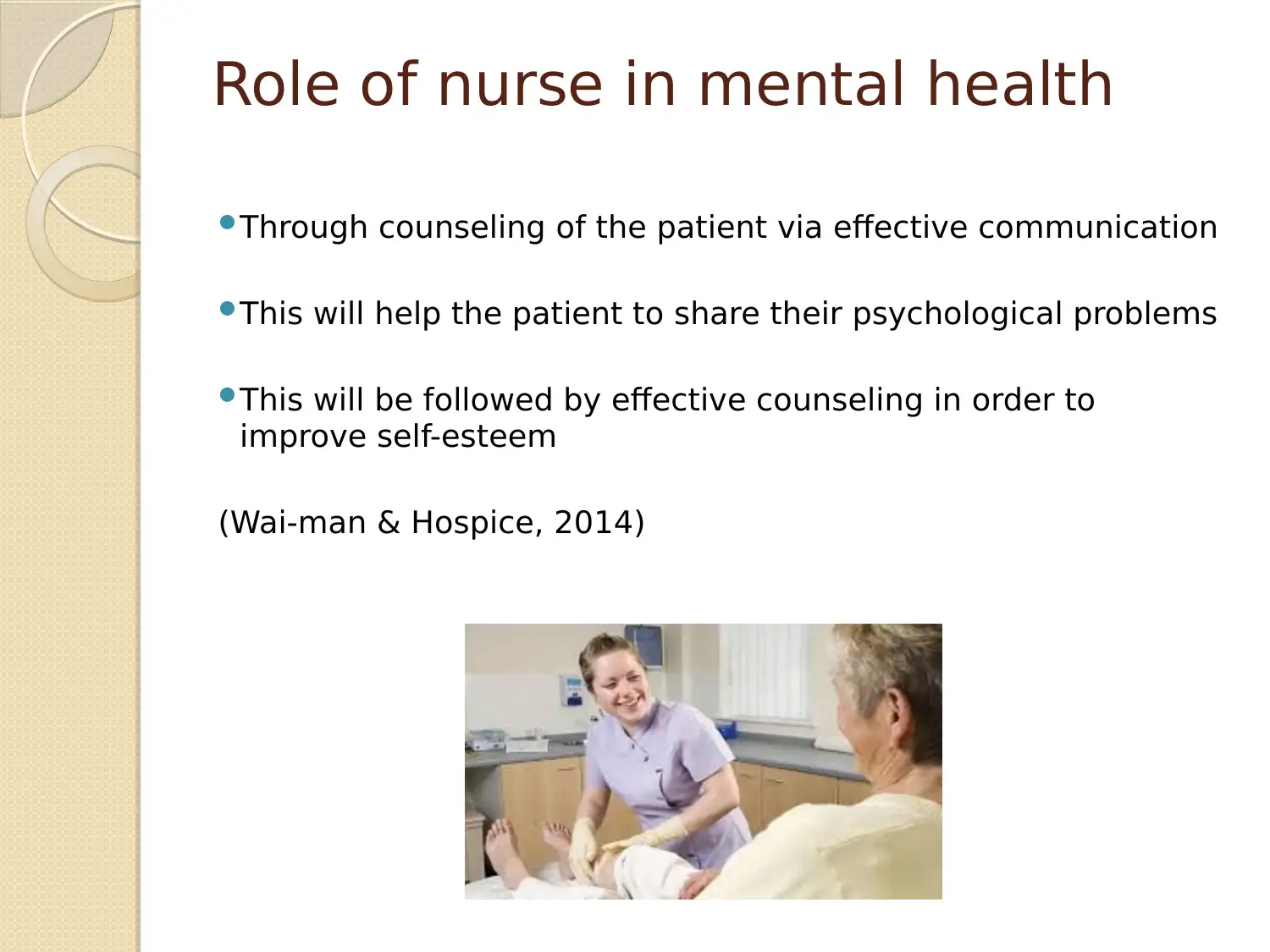
Role of nurse in mental health
Through counseling of the patient via effective communication
This will help the patient to share their psychological problems
This will be followed by effective counseling in order to
improve self-esteem
(Wai-man & Hospice, 2014)
Through counseling of the patient via effective communication
This will help the patient to share their psychological problems
This will be followed by effective counseling in order to
improve self-esteem
(Wai-man & Hospice, 2014)
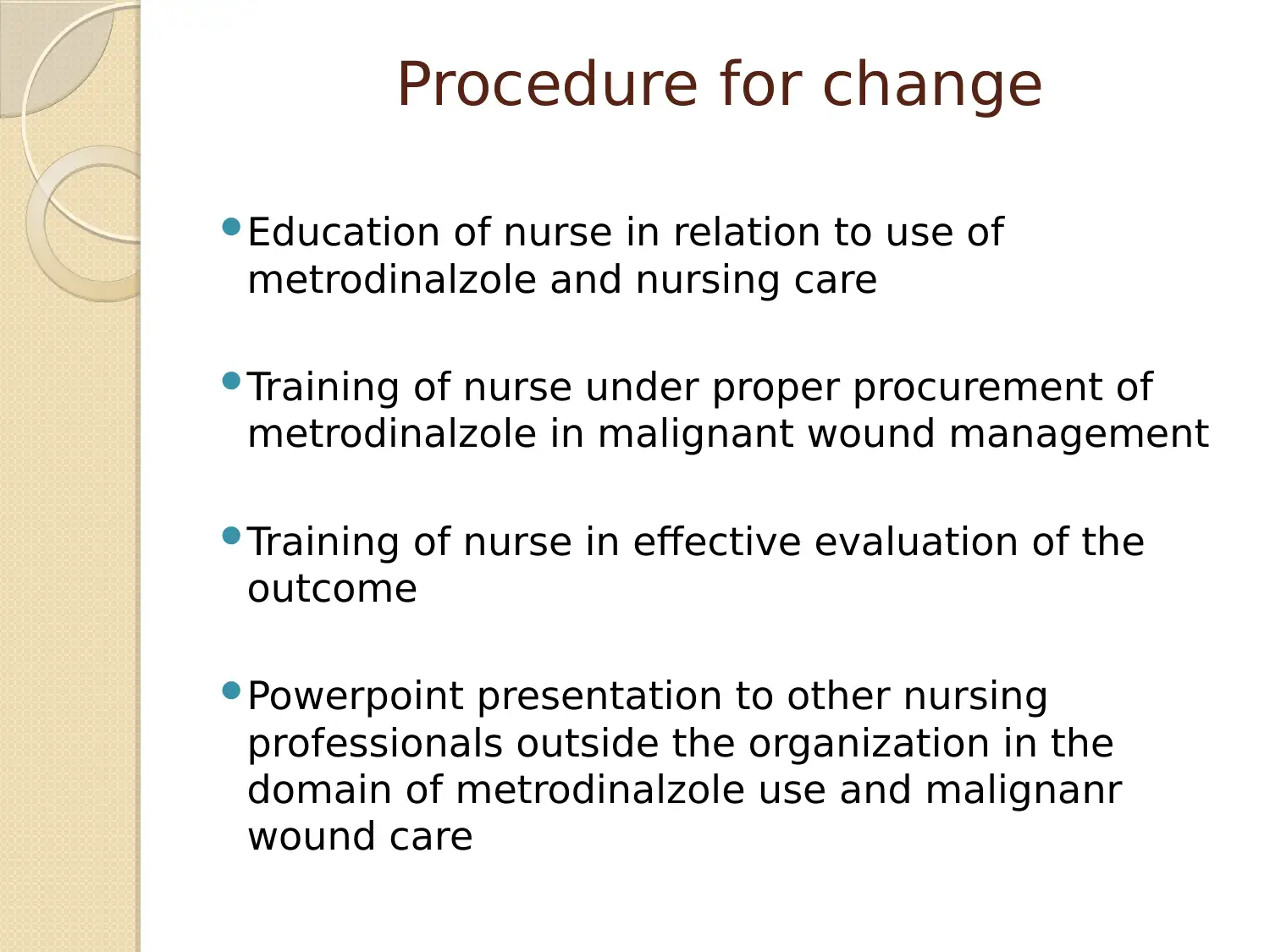
Procedure for change
Education of nurse in relation to use of
metrodinalzole and nursing care
Training of nurse under proper procurement of
metrodinalzole in malignant wound management
Training of nurse in effective evaluation of the
outcome
Powerpoint presentation to other nursing
professionals outside the organization in the
domain of metrodinalzole use and malignanr
wound care
Education of nurse in relation to use of
metrodinalzole and nursing care
Training of nurse under proper procurement of
metrodinalzole in malignant wound management
Training of nurse in effective evaluation of the
outcome
Powerpoint presentation to other nursing
professionals outside the organization in the
domain of metrodinalzole use and malignanr
wound care
Secure Best Marks with AI Grader
Need help grading? Try our AI Grader for instant feedback on your assignments.
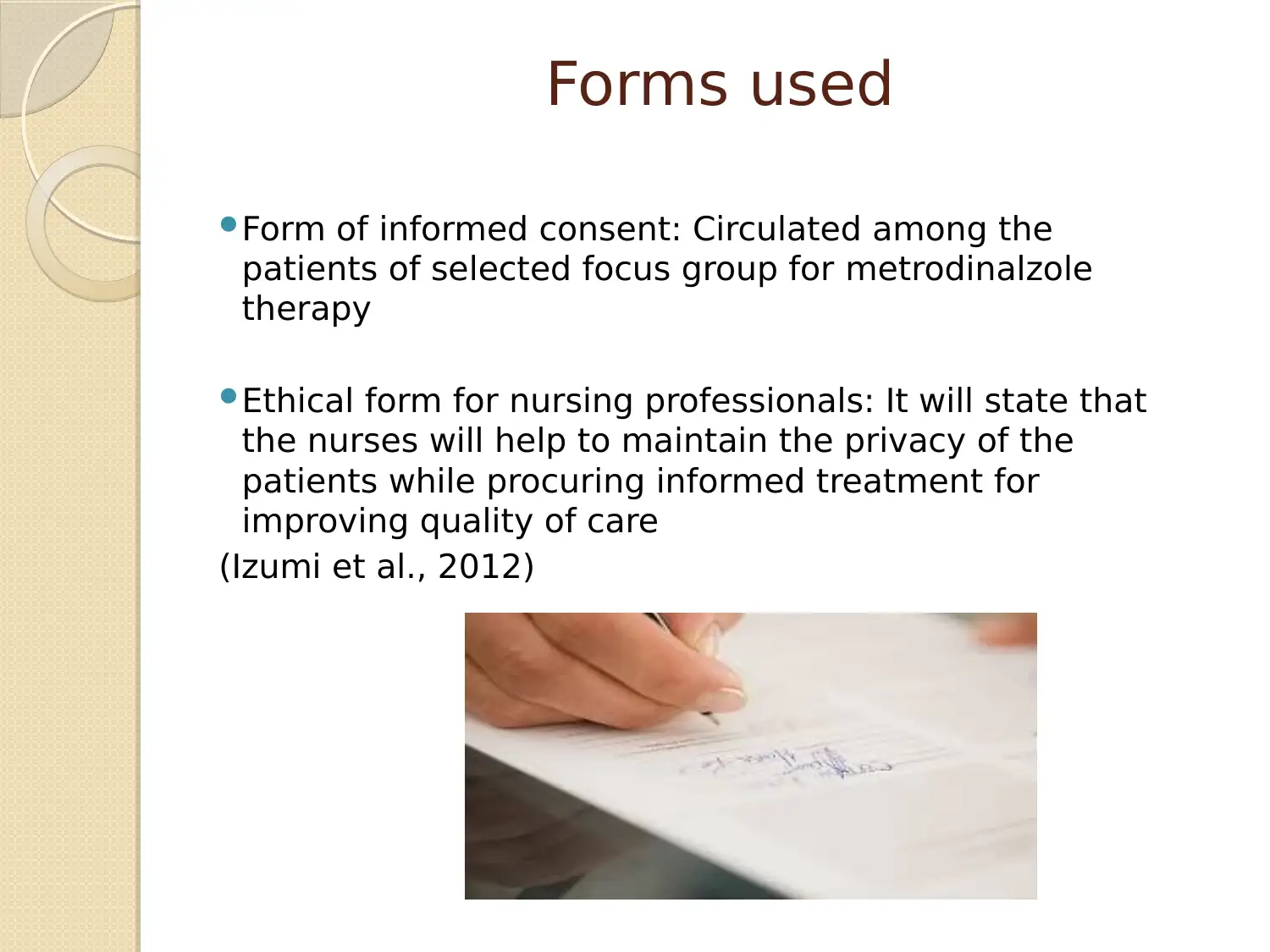
Forms used
Form of informed consent: Circulated among the
patients of selected focus group for metrodinalzole
therapy
Ethical form for nursing professionals: It will state that
the nurses will help to maintain the privacy of the
patients while procuring informed treatment for
improving quality of care
(Izumi et al., 2012)
Form of informed consent: Circulated among the
patients of selected focus group for metrodinalzole
therapy
Ethical form for nursing professionals: It will state that
the nurses will help to maintain the privacy of the
patients while procuring informed treatment for
improving quality of care
(Izumi et al., 2012)
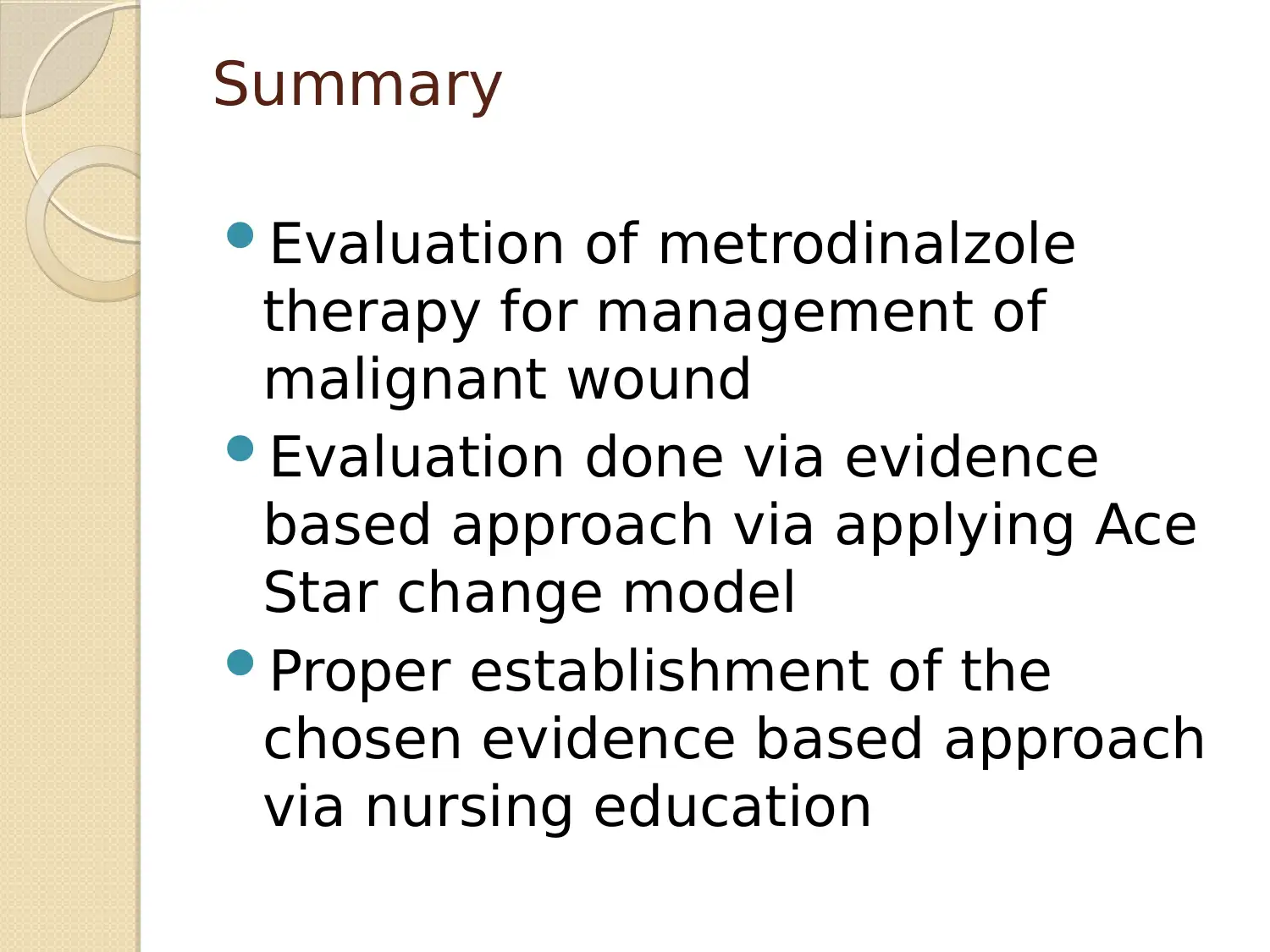
Summary
Evaluation of metrodinalzole
therapy for management of
malignant wound
Evaluation done via evidence
based approach via applying Ace
Star change model
Proper establishment of the
chosen evidence based approach
via nursing education
Evaluation of metrodinalzole
therapy for management of
malignant wound
Evaluation done via evidence
based approach via applying Ace
Star change model
Proper establishment of the
chosen evidence based approach
via nursing education
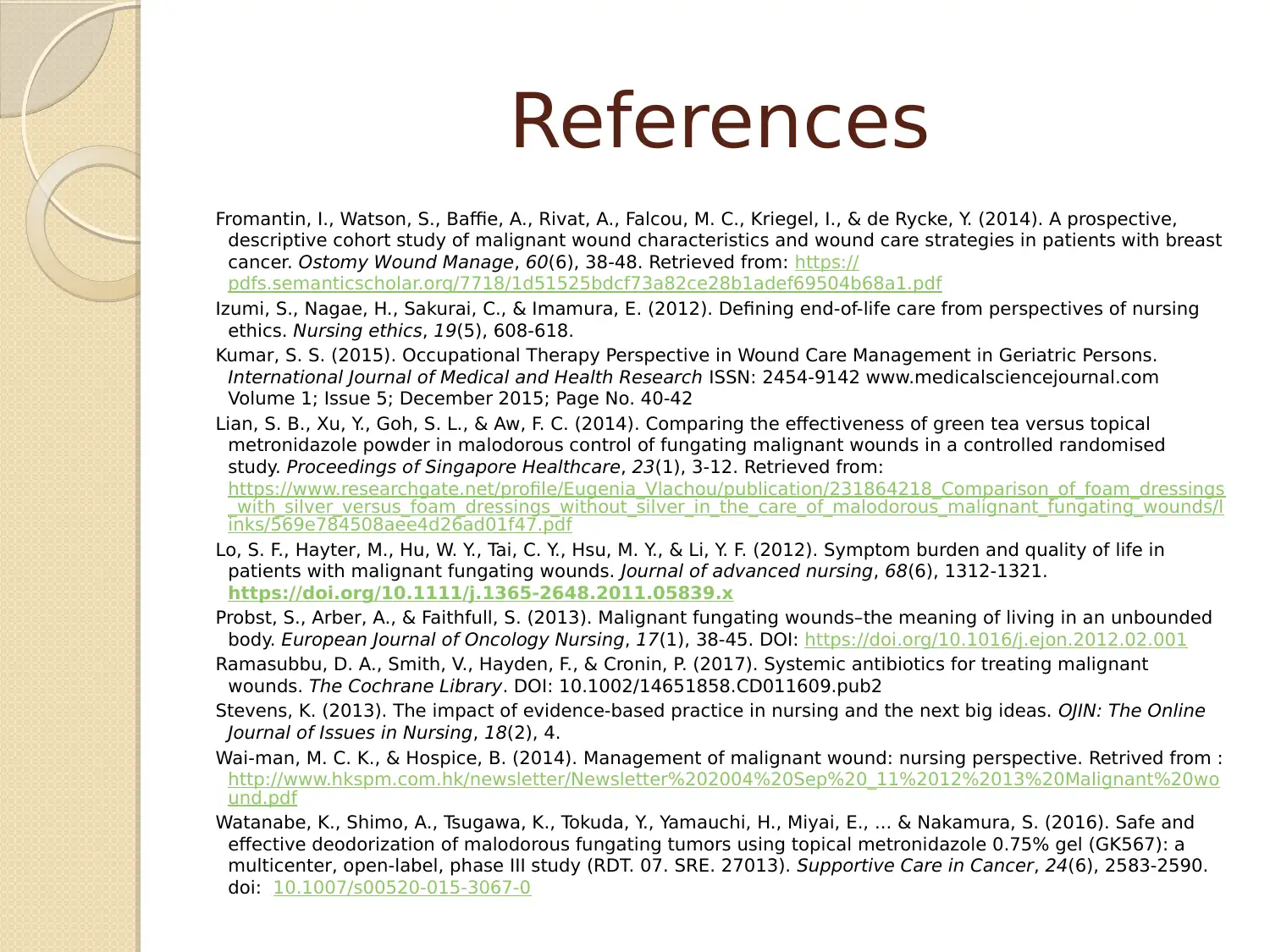
References
Fromantin, I., Watson, S., Baffie, A., Rivat, A., Falcou, M. C., Kriegel, I., & de Rycke, Y. (2014). A prospective,
descriptive cohort study of malignant wound characteristics and wound care strategies in patients with breast
cancer. Ostomy Wound Manage, 60(6), 38-48. Retrieved from: https://
pdfs.semanticscholar.org/7718/1d51525bdcf73a82ce28b1adef69504b68a1.pdf
Izumi, S., Nagae, H., Sakurai, C., & Imamura, E. (2012). Defining end-of-life care from perspectives of nursing
ethics. Nursing ethics, 19(5), 608-618.
Kumar, S. S. (2015). Occupational Therapy Perspective in Wound Care Management in Geriatric Persons.
International Journal of Medical and Health Research ISSN: 2454-9142 www.medicalsciencejournal.com
Volume 1; Issue 5; December 2015; Page No. 40-42
Lian, S. B., Xu, Y., Goh, S. L., & Aw, F. C. (2014). Comparing the effectiveness of green tea versus topical
metronidazole powder in malodorous control of fungating malignant wounds in a controlled randomised
study. Proceedings of Singapore Healthcare, 23(1), 3-12. Retrieved from:
https://www.researchgate.net/profile/Eugenia_Vlachou/publication/231864218_Comparison_of_foam_dressings
_with_silver_versus_foam_dressings_without_silver_in_the_care_of_malodorous_malignant_fungating_wounds/l
inks/569e784508aee4d26ad01f47.pdf
Lo, S. F., Hayter, M., Hu, W. Y., Tai, C. Y., Hsu, M. Y., & Li, Y. F. (2012). Symptom burden and quality of life in
patients with malignant fungating wounds. Journal of advanced nursing, 68(6), 1312-1321.
https://doi.org/10.1111/j.1365-2648.2011.05839.x
Probst, S., Arber, A., & Faithfull, S. (2013). Malignant fungating wounds–the meaning of living in an unbounded
body. European Journal of Oncology Nursing, 17(1), 38-45. DOI: https://doi.org/10.1016/j.ejon.2012.02.001
Ramasubbu, D. A., Smith, V., Hayden, F., & Cronin, P. (2017). Systemic antibiotics for treating malignant
wounds. The Cochrane Library. DOI: 10.1002/14651858.CD011609.pub2
Stevens, K. (2013). The impact of evidence-based practice in nursing and the next big ideas. OJIN: The Online
Journal of Issues in Nursing, 18(2), 4.
Wai-man, M. C. K., & Hospice, B. (2014). Management of malignant wound: nursing perspective. Retrived from :
http://www.hkspm.com.hk/newsletter/Newsletter%202004%20Sep%20_11%2012%2013%20Malignant%20wo
und.pdf
Watanabe, K., Shimo, A., Tsugawa, K., Tokuda, Y., Yamauchi, H., Miyai, E., ... & Nakamura, S. (2016). Safe and
effective deodorization of malodorous fungating tumors using topical metronidazole 0.75% gel (GK567): a
multicenter, open-label, phase III study (RDT. 07. SRE. 27013). Supportive Care in Cancer, 24(6), 2583-2590.
doi: 10.1007/s00520-015-3067-0
Fromantin, I., Watson, S., Baffie, A., Rivat, A., Falcou, M. C., Kriegel, I., & de Rycke, Y. (2014). A prospective,
descriptive cohort study of malignant wound characteristics and wound care strategies in patients with breast
cancer. Ostomy Wound Manage, 60(6), 38-48. Retrieved from: https://
pdfs.semanticscholar.org/7718/1d51525bdcf73a82ce28b1adef69504b68a1.pdf
Izumi, S., Nagae, H., Sakurai, C., & Imamura, E. (2012). Defining end-of-life care from perspectives of nursing
ethics. Nursing ethics, 19(5), 608-618.
Kumar, S. S. (2015). Occupational Therapy Perspective in Wound Care Management in Geriatric Persons.
International Journal of Medical and Health Research ISSN: 2454-9142 www.medicalsciencejournal.com
Volume 1; Issue 5; December 2015; Page No. 40-42
Lian, S. B., Xu, Y., Goh, S. L., & Aw, F. C. (2014). Comparing the effectiveness of green tea versus topical
metronidazole powder in malodorous control of fungating malignant wounds in a controlled randomised
study. Proceedings of Singapore Healthcare, 23(1), 3-12. Retrieved from:
https://www.researchgate.net/profile/Eugenia_Vlachou/publication/231864218_Comparison_of_foam_dressings
_with_silver_versus_foam_dressings_without_silver_in_the_care_of_malodorous_malignant_fungating_wounds/l
inks/569e784508aee4d26ad01f47.pdf
Lo, S. F., Hayter, M., Hu, W. Y., Tai, C. Y., Hsu, M. Y., & Li, Y. F. (2012). Symptom burden and quality of life in
patients with malignant fungating wounds. Journal of advanced nursing, 68(6), 1312-1321.
https://doi.org/10.1111/j.1365-2648.2011.05839.x
Probst, S., Arber, A., & Faithfull, S. (2013). Malignant fungating wounds–the meaning of living in an unbounded
body. European Journal of Oncology Nursing, 17(1), 38-45. DOI: https://doi.org/10.1016/j.ejon.2012.02.001
Ramasubbu, D. A., Smith, V., Hayden, F., & Cronin, P. (2017). Systemic antibiotics for treating malignant
wounds. The Cochrane Library. DOI: 10.1002/14651858.CD011609.pub2
Stevens, K. (2013). The impact of evidence-based practice in nursing and the next big ideas. OJIN: The Online
Journal of Issues in Nursing, 18(2), 4.
Wai-man, M. C. K., & Hospice, B. (2014). Management of malignant wound: nursing perspective. Retrived from :
http://www.hkspm.com.hk/newsletter/Newsletter%202004%20Sep%20_11%2012%2013%20Malignant%20wo
und.pdf
Watanabe, K., Shimo, A., Tsugawa, K., Tokuda, Y., Yamauchi, H., Miyai, E., ... & Nakamura, S. (2016). Safe and
effective deodorization of malodorous fungating tumors using topical metronidazole 0.75% gel (GK567): a
multicenter, open-label, phase III study (RDT. 07. SRE. 27013). Supportive Care in Cancer, 24(6), 2583-2590.
doi: 10.1007/s00520-015-3067-0
Paraphrase This Document
Need a fresh take? Get an instant paraphrase of this document with our AI Paraphraser

Thank You
1 out of 20
Related Documents
Your All-in-One AI-Powered Toolkit for Academic Success.
+13062052269
info@desklib.com
Available 24*7 on WhatsApp / Email
![[object Object]](/_next/static/media/star-bottom.7253800d.svg)
Unlock your academic potential
© 2024 | Zucol Services PVT LTD | All rights reserved.





